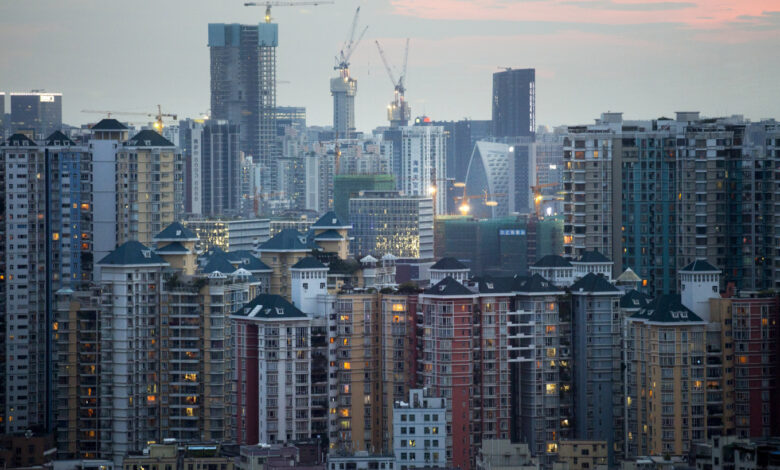With China’s property market struggling, India, South Korea and Vietnam are hot

JUST a few years ago, Asia’s commercial property market was driven largely by Hong Kong and China. With the mainland economy booming, it was easy to fill office towers in the former colony and in prosperous cities such as Beijing and Shanghai. But with China in a slump and its real estate market cratering, the focus has shifted to India, Vietnam and South Korea.
As more multinationals diversify their Asia operations beyond China, landlords in nearby countries have an increasingly strong hand. The total area leased in Asia in the first quarter was 5 per cent higher than the average of the past five years, brokerage Jones Lang LaSalle reports. That stands in sharp contrast to the US, where it was 29 per cent lower, and Europe, which was a third below the five-year average. Brokerage CBRE Group expects rents in China’s biggest cities to fall as much as 6 per cent this year. In Ho Chi Minh City, they rose 6.6 per cent in the first quarter from a year ago, one of the biggest gains in Asia, according to real estate broker Knight Frank.
In India, the square footage of leases signed in the first quarter was the second-highest on record, JLL reports. “In the past, the Asia story has been dominated by China,” said Jeremy Sheldon, head of Asia-Pacific markets at JLL. “Now it’s ‘OK, China is still incredibly important, but what else is out there?’ “
India is chipping away at China’s dominance in manufacturing as companies diversify supply chains. The country is home to Samsung Electronics’s biggest mobile phone factory, while contract manufacturers there make at least 7 per cent of Apple’s iPhones. Last November the value of Indian electronics exports to the US was 7.7 per cent of what China exported-not much, but three times what it was two years earlier, according to Fathom Financial Consulting in London. And the India-China ratio for exports to the UK more than doubled in the period, to 10 per cent.
Demand for space has been particularly strong from the booming technology and financial sectors. While India traditionally was seen as the place for back-office operations, more foreign companies are setting up research and development hubs in the country, says Henry Chin, head of research for Asia-Pacific at CBRE. “Most of the expansion need of multinational companies is in India now,” Chin says.
Rents rose 5.6 per cent in Mumbai and 3.6 per cent in Delhi in 2023, CBRE reports. Finance firm ICICI Securities, for instance, has booked 188,000 square feet in the Mindspace Juinagar development in Mumbai, and Nvidia has a new lease for 73,000 square feet in the 16-storey HQ27 tower near Delhi, according to Cushman & Wakefield. And companies are venturing beyond the major business centres to cities such as Chennai and Pune, tech hubs with lots of potential workers, according to CBRE. California semiconductor company Qualcomm last year rented 500,000 square feet in Chennai, as well as 600,000 square feet in Bengaluru.
A NEWSLETTER FOR YOU

Property Insights
Get an exclusive analysis of real estate and property news in Singapore and beyond.
In Vietnam, pledged foreign investment jumped by a third last year as the country emerges as a key alternative to China, with the bulk of money going into manufacturing. Apple, Intel and Samsung suppliers all now have facilities there, and Meta Platforms said it’s weighing an expanded investment in the country. “Particularly, Vietnam is very strong in terms of rental growth,” said Christine Li, Knight Frank’s Asia-Pacific research chief. “Demand is really shifting from China to the rest of South-east Asia and India.”
China’s commercial property market faces two problems. More companies are pursuing a so-called China-plus-one strategy-shifting production away from the mainland to mitigate the risk of a rupture in relations between China and the US and European Union. And after office construction delays during the pandemic, “we are still seeing a lot of supply being delivered” just as demand plummets, Li said. Even as a quarter of top-quality offices in the southern tech hub of Shenzhen sit empty, new construction will increase available space there by 23 per cent this year, Knight Frank predicts. The 52-storey China Venture Capital Building and a portion of the multi-tower Qianhai Exchange Square development, both opening this year, together will add more than three million square feet of space.
In Seoul, with a lack of available space and resilient demand from local companies, rents will rise more than 5 per cent this year, according to CBRE. Space in Seoul has been in short supply since 2021 because of redevelopment restrictions and construction disruption during the pandemic. As a result, it has an occupancy rate of about 98 per cent, the highest of any major city worldwide, CBRE said. “It is difficult for tenants to find the place they want,” said YJ Choi, an agent at brokerage Cushman & Wakefield Korea. “And there is almost no new supply in key areas.”
Investors are taking note and seeking opportunities in countries benefiting from the shift away from China. Goodwin Gaw, chairman of real estate private equity firm Gaw Capital Partners, which manages more than US$30 billion in assets, is particularly bullish on Vietnam, where his firm owns developments such as the Lim Tower, a 34-storey building in the heart of Ho Chi Minh City. “As long as there’s geopolitics between China and the US,” Gaw told Bloomberg Television in March. “The China-plus-one strategy will continue.” BLOOMBERG

